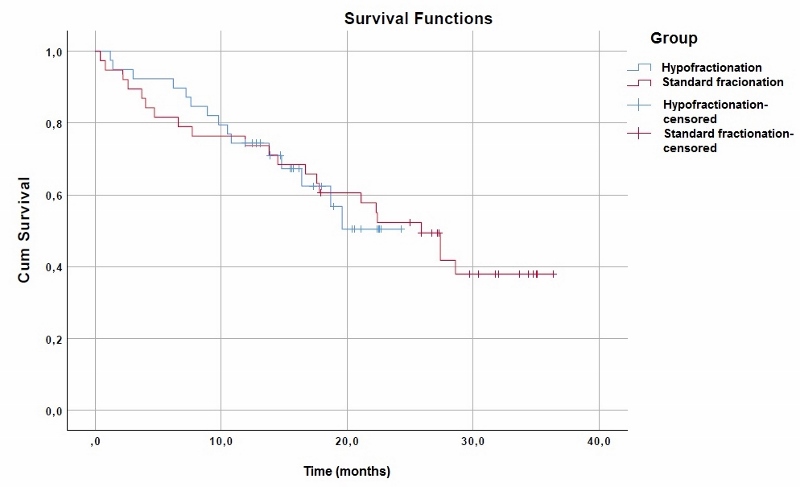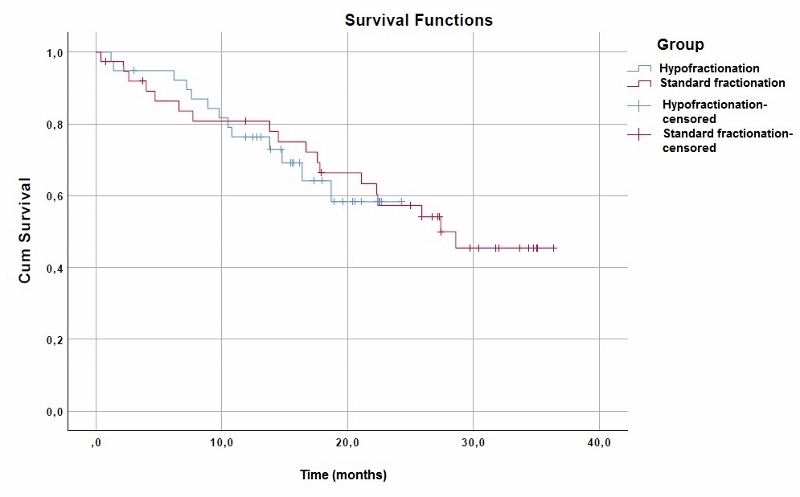Survival differences of hypofractionation vs. standard-fractionation in lung cancer: a cohort study
Macarena M. Teja Ubach,
Spain
PO-1309
Abstract
Survival differences of hypofractionation vs. standard-fractionation in lung cancer: a cohort study
Authors: Macarena M. Teja Ubach1, Áurea Manso de Lema1, Raúl Matute Martín2, Elísabet González del Portillo1, Mercedes González Cantero1, M. Isabel Garrido Botella1, Marta Rodríguez Roldán1, Rafael Rosel Aller1, Isabel Rodríguez Rodríguez1, Rosa Morera López1
1Hospital Universitario La Paz, Radiation Oncology, Madrid, Spain; 2Centro de Protonterapia Quirónsalud, Radiation Oncology, Madrid, Spain
Show Affiliations
Hide Affiliations
Purpose or Objective
Lung cancer is the second most common cancer and it is the leading cause of cancer death. Standard treatment for locally advanced Non-Small-Cell Lung-Cancer (NSCLC) and for non-metastatic Small-Cell Lung-Cancer (SCLC) is concomitant radio-chemotherapy. Secuential chemo-radiotherapy and radiotherapy alone may also be used as a radical treatment option for those patients who are unfit for a concomitant chemo-radiotherapy.
The main objective of this study was to compare overall survival between a cohort of lung cancer patients treated with standard fractionation and a cohort treated with hypofractionation.
Secondary Objectives were to compare cancer-specific mortality and progression free survival between the two cohorts.
Material and Methods
Overall survival, cancer-specific mortality and progression free survival were retrospectively compared between two cohorts of non-metastatic lung cancer patients.
Cohort 1 (from April 2020 to April 2021) was treated with hypofractionation. For NSCLC, the radiotherapy scheme used was 55Gy in 20 fractions (2,75Gy daily fraction) with concurrent chemotherapy or 52,5Gy in 15 fractions (3,5Gy daily fraction) without concurrent chemotherapy. For SCLC 40,05Gy in 15 fractions (2,67Gy daily fraction) was administered.
Cohort 2 (from March 2019 to March 2020) received standard fractionation radiotherapy: 60 to 66Gy, 1,8-2Gy daily fractions with or without concurrent chemotherapy.
Chi-square, ANOVA and Kaplan-Meier were used in the statistical analysis.
Results
Seventy seven patients were included. Median age was 67,88 years (±8,26). Fifty patients (64,9%) were men and 27 patients (35,1%) were women. The most frequent histology was NSCLC (61%) and most patients were stage III at the diagnosis (79,7%). The cohorts were homogeneous. After one year of follow up of every patient, no statistically significant differences were found in terms of overall survival between cohorts (p=0,915) (Figure 1). No statistically significant differences were observed neither in cancer-specific mortality (p=0,804) (Figure 2) nor in progression free survival (p=0,270).
Figure 1. Overall Survival

Figure 2. Cancer Specific mortality

Conclusion
As for now, our study showed no differences in terms of global survival neither in cancer-specific mortality between hypofractionation and standard fractionation in lung cancer treatment after one year of follow-up of every patient. However, this is a single centre study with a small sample of patients, so clinical trials are needed to corroborate our results and longer follow-up is necessary to verify that they are maintained over time.